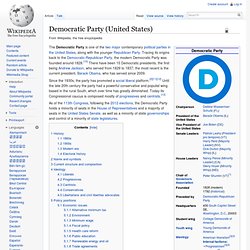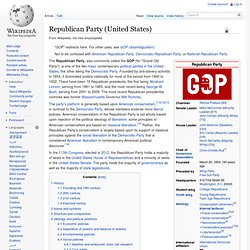

WIKI. Democratic Party (United States) - Wikipedia, the free encyclope. Since the 1930s, the party has promoted a social liberal platform.[2][11][12] Until the late 20th century the party had a powerful conservative and populist wing based in the rural South, which over time has greatly diminished.

Today its Congressional caucus is composed mostly of progressives and centrists.[13] History The Democratic Party evolved from the Jeffersonian Republican or Democratic-Republican Party organized by Thomas Jefferson and James Madison in opposition to the Federalist party of Alexander Hamilton and John Adams. The party favored republicanism, a weak federal government, states' rights, agrarian interests (especially Southern planters) and strict adherence to the Constitution; it opposed a national bank, close ties to Great Britain, and business and banking interests. The Party came to power in the election of 1800. 1860s 1900s Modern era Electoral history Name and symbols "A Live Jackass Kicking a Dead Lion" by Thomas Nast.
Republican Party (United States) - Wikipedia, the free encyclope. History Founding and 19th century The first official party convention was held on July 6, 1854, in Jackson, Michigan.

By 1858, the Republicans dominated nearly all Northern states. The Republican Party first came to power in 1860 with the election of Lincoln to the Presidency and Republicans in control of Congress and again, the Northern states. It oversaw the saving of the union, the end of slavery, and the provision of equal rights to all men in the American Civil War and Reconstruction, 1861–1877.[16] The Republicans' initial base was in the Northeast and the upper Midwest. Early Republican ideology was reflected in the 1856 slogan "free labor, free land, free men", which had been coined by Salmon P.
The GOP supported business generally, hard money (i.e., the gold standard), high tariffs to promote economic growth, high wages and high profits, generous pensions for Union veterans, and (after 1893) the annexation of Hawaii. 20th century Warren G. 21st century Electoral history. The Colbert Report. Totalitarianism. Hannah Arendt. Life and career[edit] Arendt was born into a secular family of German Jews in Linden (present-day Hanover), the daughter of Martha (born Cohn) and Paul Arendt.[7] She grew up in Königsberg (renamed Kaliningrad and annexed to the Soviet Union in 1946) and Berlin.

At the University of Marburg, she studied philosophy with Martin Heidegger. According to Hans Jonas, her only German-Jewish classmate, Arendt embarked on a long and stormy romantic relationship with Heidegger, for which she later was criticized because of Heidegger's support for the Nazi Party when he was rector at the University of Freiburg. In the wake of one of their breakups, Arendt moved to Heidelberg, where she wrote her dissertation under the existentialist philosopher-psychologist Karl Jaspers on the concept of love in the thought of Saint Augustine.
In 1929, in Berlin, she married Günther Stern, later known as Günther Anders. Paris[edit] New York[edit] Post-war[edit] Death[edit] Works[edit] The Origins of Totalitarianism[edit]